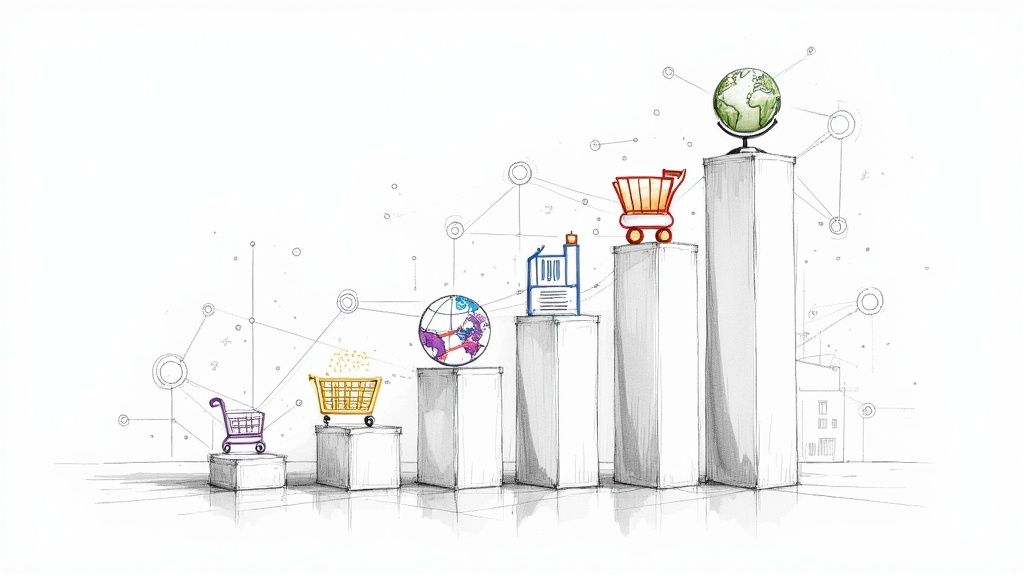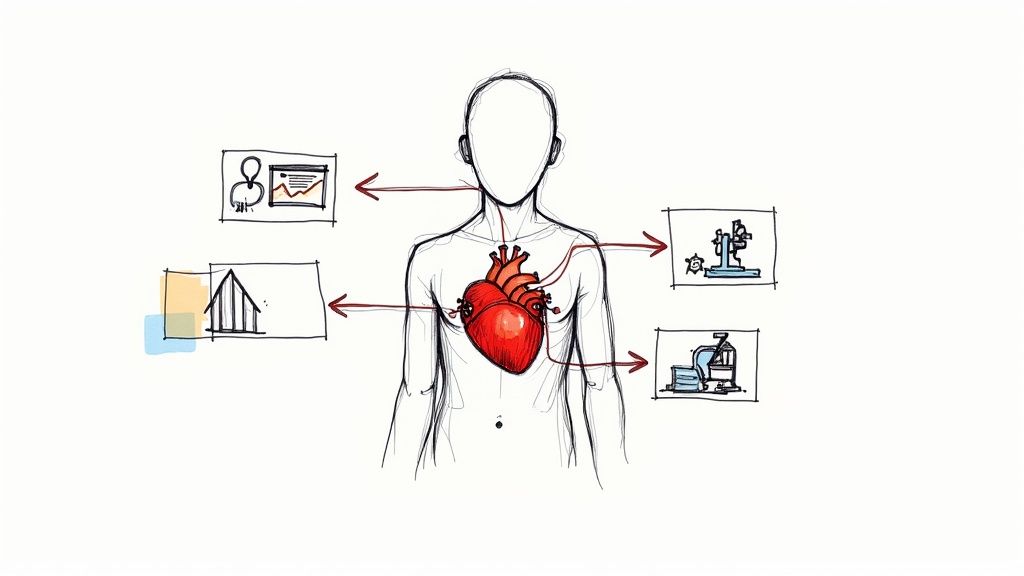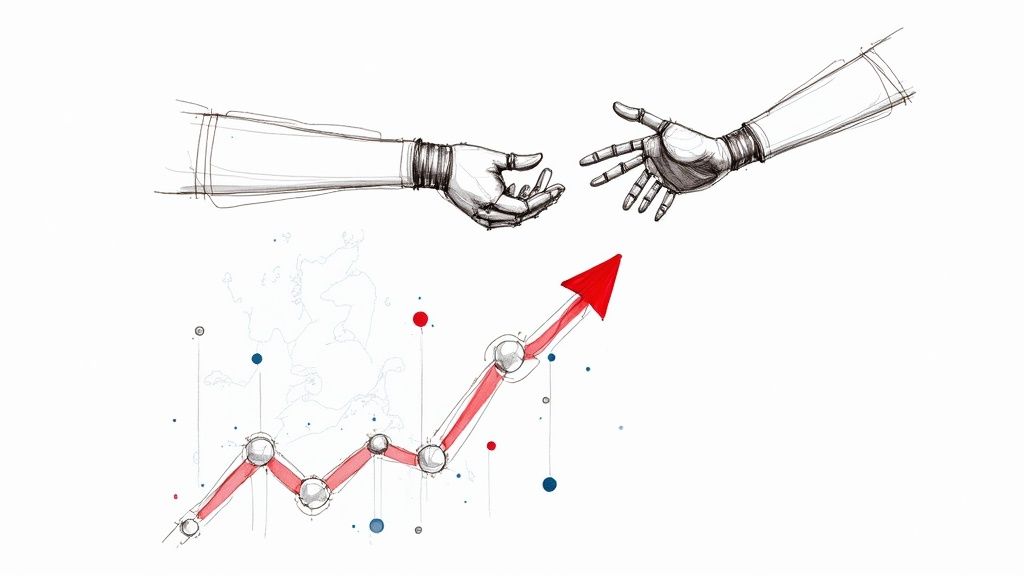AI in Medicine Unlocking Healthcare Innovation
Discover how AI in medicine is transforming patient care, diagnostics, and treatment. Learn how to implement AI strategies for real-world results.
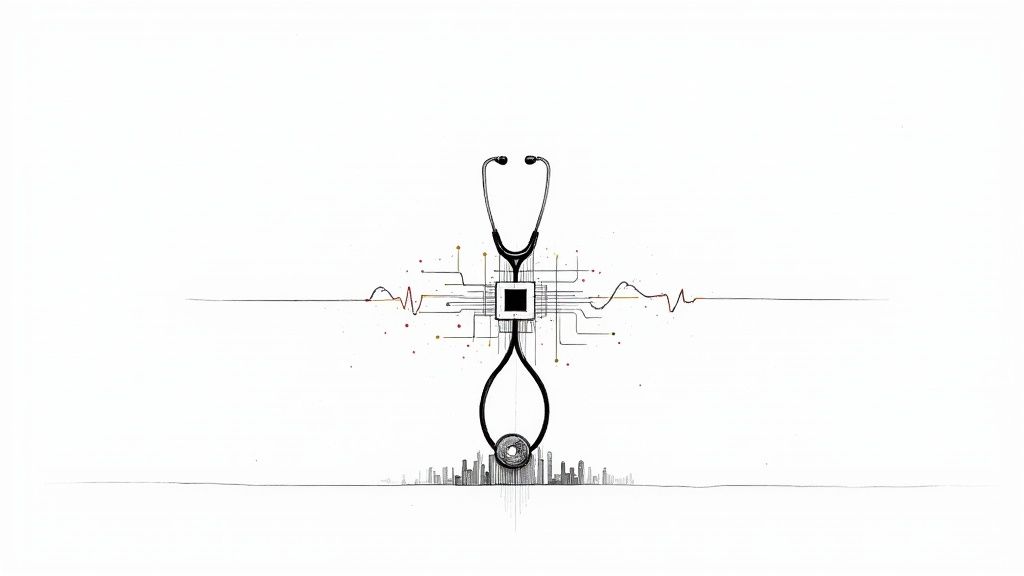
The idea of AI in medicine isn't some far-off sci-fi concept anymore. It's here, right now, and it's already making a real difference in patient care. Think of it less as a replacement for doctors and nurses and more as an incredibly powerful partner, enhancing their skills with insights crunched from vast amounts of data.
The New Reality of AI in Modern Medicine
Artificial intelligence is acting as a new kind of assistant for clinicians, one that can sift through complex medical information—everything from CT scans to genetic code—at a speed no human could ever match. This capability is changing the game. It helps doctors spot diseases sooner, create treatments tailored to an individual's unique biology, and even make hospitals run more smoothly.
The public is clearly leaning into this shift. Every single day, over 50 million health-related sessions are initiated on AI platforms like Bing and Copilot. People are actively seeking out digital tools for their health concerns.
This guide will walk you through the real-world impact of AI in medicine. We’ll go beyond the hype to look at what this technology actually does and, more importantly, how you can put it to work. It's all about practical application and smart integration.
A Collaborator, Not a Competitor
Let's clear up the biggest myth right away: AI is not here to replace medical professionals. Instead, it’s a collaborative tool. AI is a master of pattern recognition. It can spot tiny, almost invisible anomalies on an MRI or predict which patients are at high risk for a complication based on their health records.
This frees up doctors and nurses to do what they do best—handle complex diagnoses, connect with patients, and provide compassionate care. It's about augmenting human intelligence, not making it obsolete.
By combining the sheer volume of medical knowledge with lightning-fast analysis, AI can offer clinical insights that go beyond what any single human physician could achieve, acting as an essential support for critical decisions.
The Path Forward
Throughout this guide, we'll dive into the specific applications that are making the biggest waves in the industry.
We'll cover key areas like:
- Smarter Diagnostics: See how AI algorithms are boosting the accuracy and speed of detecting diseases like cancer from medical images.
- Personalized Treatment Plans: Explore how we're moving past generic treatments by using AI to analyze an individual's specific health data.
- Streamlining Hospital Operations: Learn how automating administrative tasks can slash costs and give medical staff more time for patients.
Making this transition successfully requires a clear strategy. The goal is to turn technological potential into measurable improvements in the healthcare industry, and that starts with a solid plan.
How AI Is Sharpening Medical Diagnostics
In medical diagnostics, every second counts, and accuracy is non-negotiable. For decades, we've relied on the sharp, trained eyes of radiologists and pathologists to find subtle signs of disease in a sea of complex images. But the sheer volume of scans they review is staggering, and human fatigue is a real factor. This is precisely where AI in medicine is making its mark—not as a replacement, but as an incredibly powerful tool to augment human expertise.

Imagine an AI algorithm as a tireless colleague that has meticulously analyzed millions of medical images. It learns to spot patterns linked to specific conditions—patterns so faint they might be missed by the human eye at the end of a long shift. It’s about giving our experts a second, hyper-vigilant set of eyes to confirm their findings and catch what might otherwise be overlooked.
Achieving Superhuman Precision in Medical Imaging
One of the most immediate and tangible impacts of AI is in analyzing medical images like X-rays, CT scans, and MRIs. We're seeing machine learning models, especially deep learning networks, trained on immense, high-quality datasets of labeled scans. This process essentially teaches the AI to tell the difference between healthy tissue and the very first signs of disease.
For instance, an AI reviewing a mammogram can flag microscopic calcifications that are often precursors to cancer. In neurology, it can identify the subtle brain atrophy that signals early-stage Alzheimer's long before a patient shows clear symptoms. This ability fundamentally changes the timeline for treatment, opening the door for earlier, more effective intervention.
AI's capacity to process and interpret visual data at an immense scale brings a level of diagnostic scrutiny that was simply out of reach before, allowing us to find diseases at their most treatable stage.
This isn't a futuristic concept; it's happening right now. AI systems designed for cancer detection have already shown sensitivities and specificities that, in some studies, meet or even exceed those of human radiologists. By 2023, this trend was solidifying, with a global survey showing that 65 percent of over 2,400 hospitals had integrated AI predictive models into their electronic health records to help guide clinical decisions.
From Simple Detection to True Decision Support
Modern AI tools do much more than just circle a suspicious spot on a scan. They are becoming deeply integrated clinical partners that provide context and data-backed insights, helping clinicians make smarter decisions more quickly.
- Speeding Up Triage: In a chaotic ER, an AI can analyze a chest X-ray for signs of pneumonia in seconds, helping doctors prioritize the most critical cases first.
- Cutting Down on Human Error: By handling the initial, often repetitive review of scans, AI reduces the cognitive burden on radiologists, which in turn minimizes the risk of fatigue-related mistakes.
- Forecasting Disease Progression: For conditions like diabetic retinopathy, an AI can analyze retinal images to predict the likelihood of future vision loss, prompting doctors to pursue more aggressive treatment early on.
This seamless integration is what makes the technology so powerful. Platforms are now designed to plug directly into electronic health records (EHRs), presenting AI-generated insights right alongside a patient's other data. This gives the physician a complete, holistic view. For example, a tool like Diagnoo is built to fit into existing medical workflows, turning a flood of complex data into clear, actionable intelligence.
This partnership—blending machine precision with human experience—isn't just a minor improvement. It’s changing patient outcomes by drastically shortening the anxious wait for a diagnosis. By catching diseases earlier and with greater confidence, AI in medicine is shifting diagnostics from a reactive guessing game to a proactive science.
Crafting Personalized Treatments with AI
The old "one-size-fits-all" model for medicine is quickly becoming a relic of the past. We're now stepping into an era of truly personalized treatment, where therapies are no longer designed for the "average" patient but are tailored to the individual. Think of it less like buying off the rack and more like visiting a bespoke tailor for your health—one who meticulously crafts a plan that fits your unique biological and genetic profile.
This incredible level of precision is only possible because AI algorithms can chew through massive, complex datasets and spot patterns that would be invisible to the human eye. They can analyze a patient's genomic data, lifestyle habits, electronic health records, and even real-time data from wearables, all at once. By connecting these dots, AI helps doctors predict how someone will respond to a specific therapy, which means better results and fewer side effects. This is where expert healthcare software development comes in, translating these torrents of data into clear, actionable clinical insights.
This schematic shows how AI takes multiple data streams to generate personalized medical insights, much like a neural network interpreting a complex brain scan.
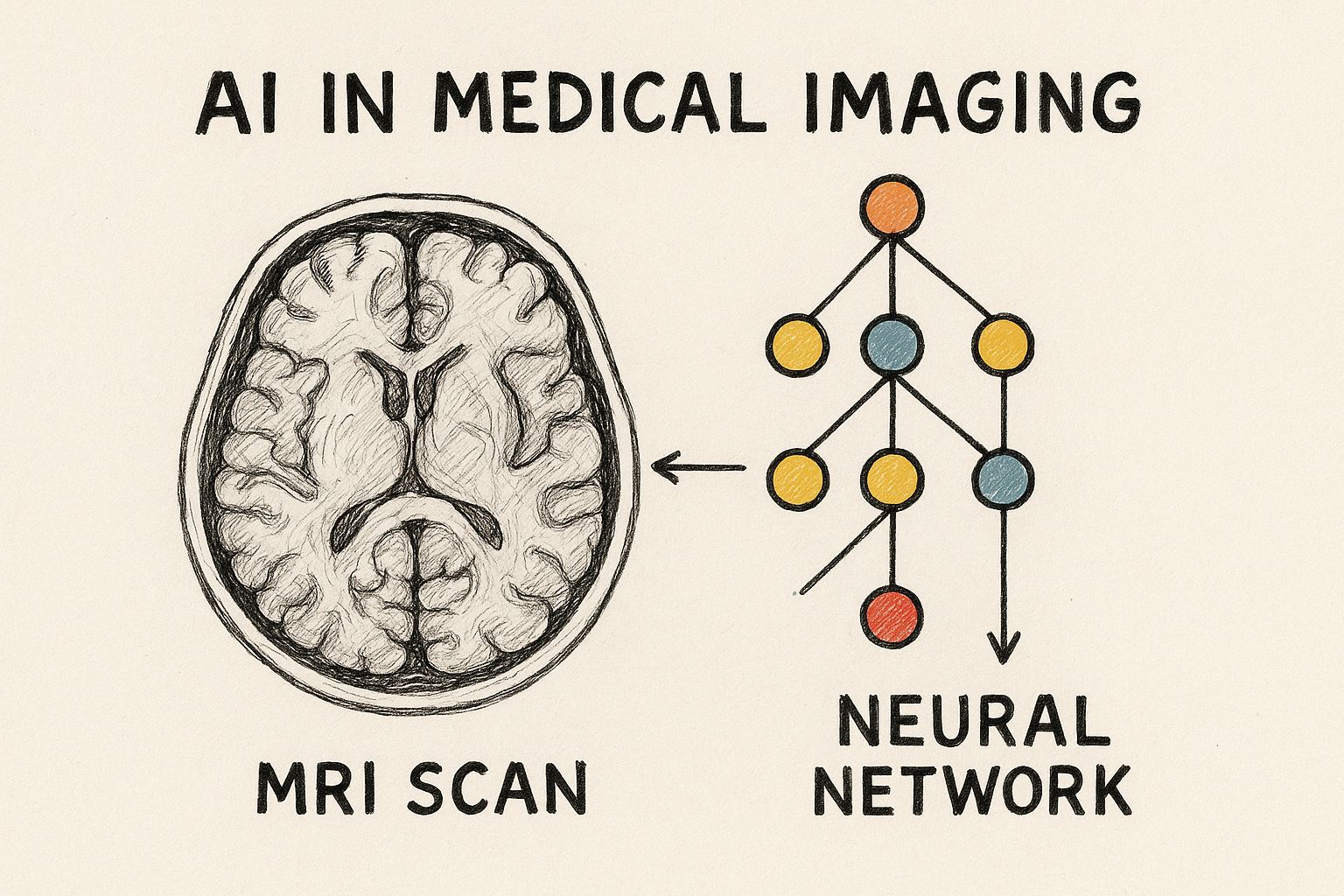
The image perfectly captures the blend of biological data and sophisticated computation that sits at the heart of AI-driven personalized medicine.
From Genetic Code to Custom Care
Genomics is ground zero for this medical shift. Each person's genetic makeup holds vital clues about their risk for certain diseases and how their body might react to different medications. Trying to decipher this information manually is a Herculean task. For AI, however, it's just another day at the office.
AI models can rapidly scan a patient's entire genome to pinpoint specific genetic markers that can make or break a treatment's success. In oncology, for example, AI can analyze a tumor's unique genetic signature to suggest the chemotherapy drug most likely to be effective, while minimizing harm to healthy cells. It turns cancer treatment from a blunt instrument into a precision-guided tool.
AI's ability to decipher our individual genetic blueprints is the key to creating therapies that are not just reactive but predictive, addressing the root cause of disease with unparalleled accuracy.
Accelerating the Pace of Drug Discovery
Beyond just personalizing existing treatments, AI is also putting the process of creating new ones on the fast track. Traditional drug discovery is notoriously slow and expensive—it can easily take over a decade and cost billions, with a painfully high failure rate. AI is fundamentally changing that math by making every step of the process smarter and more efficient.
- Finding Promising Candidates: AI algorithms can screen millions of molecular compounds in a tiny fraction of the time it would take human researchers, flagging those most likely to work against a particular disease.
- Optimizing Clinical Trials: By using predictive analytics, AI can help identify the ideal patient groups for clinical trials, making sure the right people are enrolled. This boosts the chances of a successful trial and gets new drugs to market faster.
- Repurposing Existing Drugs: AI can even find new life for drugs that are already approved. By analyzing their molecular structures, it can spot potential uses for entirely different diseases, creating a shortcut to new treatment options.
This strategic approach demonstrates the power of a well-designed AI Product Development Workflow, turning a long, winding research process into a focused and agile system. By pinpointing viable drug candidates early, as we explored in our AI adoption guide, AI helps avoid costly dead ends and delivers life-saving innovations to patients much sooner. It’s a perfect example of successful AI adoption and showcases some of the most impactful AI tools for business available in the healthcare world today.
Boosting Hospital Efficiency with AI Automation
While AI often grabs headlines for its role in diagnostics and treatment, its work behind the scenes is just as crucial. Hospitals are incredibly complex operations. Even a small bottleneck in one department can create a domino effect, leading to overworked clinicians, rising costs, and frustratingly long wait times for patients. This is where AI automation is making a massive difference, tuning up the very engine of hospital operations.
The real goal here isn’t just about trimming budgets. It's about giving medical professionals back their most valuable resource: time. By handing over the repetitive, administrative grind to AI, we allow doctors, nurses, and support staff to focus on the human side of medicine. This simple shift makes the entire system more resilient, responsive, and ultimately, better for patients.
Streamlining Administrative and Clinical Workflows
Ask any clinician what drains their day, and you'll likely hear one word: paperwork. AI is tackling this head-on by automating the endless administrative tasks that get in the way of patient care. Think of an AI that intelligently manages appointment schedules, not just booking slots but optimizing the entire day to minimize gaps and even predict no-shows. The same systems can handle the complexities of medical billing and coding, dramatically improving accuracy and cutting down on the claim denials that plague hospital finances.
One of the most exciting developments is AI-powered ambient listening. These tools work quietly and securely in the background during a patient consultation. They listen to the natural conversation and automatically turn it into perfectly structured clinical notes. This alone can save a physician hours of typing every single day, directly fighting the burnout that has become an epidemic in the medical community.
Integrating these kinds of AI automation strategies doesn't just fix one problem; it creates a more connected and intelligent operational environment from the ground up.
Optimizing Hospital Resource Management
Beyond individual workflows, AI is also becoming the central nervous system for managing a hospital's physical resources. This means everything from knowing which beds are free to making sure the supply closet is never empty.
- Intelligent Bed Management: AI can look at patient data and predict discharge times with surprising accuracy. This gives staff a head-start on preparing rooms, which helps get patients admitted from the emergency department faster.
- Supply Chain Optimization: Imagine a system that monitors the use of surgical gloves, syringes, and other critical supplies in real time. It can anticipate when stock will get low and automatically place new orders, preventing a crisis before it ever happens.
- Staffing Allocation: By analyzing patient admission trends, AI can recommend the ideal staffing levels for every department on every shift. This ensures that a unit is never caught short-handed during a rush or overstaffed during a quiet period.
By taking over the logistical headaches of running a hospital, AI makes sure clinical teams have what they need, right when they need it. This frees them up to deliver the best possible care without interruption.
Healthcare organizations around the world are moving quickly to adopt these tools. The push is driven by a real need to address workforce shortages and cut down on the administrative overload. In fact, a recent survey showed that 86% of healthcare organizations are already using AI extensively. With the global healthcare AI market expected to shoot past $120 billion by 2028, it's clear this isn't just a trend. It's a fundamental shift, powered by AI's proven ability to take routine work—from scheduling to documentation—off of human plates. You can explore more of these AI in healthcare statistics on blueprism.com.
Ultimately, making hospital operations more efficient isn't just a side benefit of AI; it's a core piece of the strategy. It’s how we build a smarter, more durable healthcare system where technology manages the logistics, so people can focus on healing.
Navigating AI's Ethical and Practical Challenges
For all its promise, AI in medicine isn't a magic bullet. It brings a host of complex challenges to the table. We've seen how it can sharpen diagnostics and smooth out operations, but it's crucial to look at the whole picture. Bringing this technology into the clinic responsibly means we have to face the ethical and practical hurdles head-on. This isn't about pumping the brakes on innovation; it's about being smart and deliberate.

Getting AI integration right takes more than powerful algorithms. It demands a thoughtful strategy that earns the trust of both clinicians and their patients, ensuring every new tool serves people first. This is exactly why a commitment to responsible AI co creation is absolutely essential.
The Dangers of Algorithmic Bias
One of the biggest red flags is algorithmic bias. AI models are like students—they learn from the materials they're given. If the training data reflects existing biases in society, the AI will not only learn those biases but can actually make them worse. For instance, if an algorithm for spotting skin cancer is trained mostly on images of light-skinned patients, its accuracy could plummet for patients with darker skin.
The real-world fallout is serious. We're talking misdiagnoses, flawed treatment plans, and a widening of the very health disparities we're trying to close. The only way to counter this is to intentionally build and train models on diverse, representative datasets. This proactive work is what makes sure the AI tools for business we create are effective and fair for everyone.
Data Privacy and Security Concerns
There’s not much information more personal than our health data. Naturally, using AI systems that need to process huge volumes of this data sets off alarm bells around privacy and security.
Following regulations like HIPAA is just the starting point. Real security and trust require a deeper commitment. This means:
- Data Anonymization: Systematically stripping out all personally identifiable information before data ever touches an AI model.
- Robust Cybersecurity: Putting strong encryption and secure infrastructure in place to shield sensitive data from breaches.
- Transparent Policies: Being upfront and clear with patients about how their data will be used—and why.
Managing AI Hallucinations and Regulatory Oversight
ECRI didn't mince words when it named AI the top health technology hazard for 2025. They pointed to the real danger of AI producing false or biased outputs—sometimes called "hallucinations"—and its tendency to perform unevenly across different patient populations. The risk is especially acute for marginalized communities, where biased AI can amplify existing health inequities. You can discover more about these findings on ecri.org.
An AI model is only as reliable as the data it's trained on and the ethical framework guiding it. Without rigorous oversight, even the most advanced technology can fail in critical, real-world situations.
This warning underscores the immediate need for strong regulatory guardrails and a system of continuous monitoring for AI tools after they’ve been deployed. Healthcare organizations need solid processes to catch and fix errors on the fly. Getting this right is complicated, which is why leaning on expert AI strategy consulting from the very beginning can make all the difference in building a safe and effective program.
Your Roadmap for AI Implementation
Thinking about bringing AI into your healthcare organization? It's not a single "on" switch. It’s a journey that needs a solid plan to make sure these new tools actually help your clinicians and patients. You have to move from just talking about AI to making it a reality, and that starts with a clear vision and a series of deliberate steps.
The very first thing you need to do is define what success looks like. Are you trying to get diagnostic results back faster? Maybe you want to cut down on the administrative busywork that leads to burnout, or just make patient flow through the hospital smoother. If your goals are vague, your efforts will be scattered. Pinpointing specific, measurable outcomes is the only way to build a successful AI initiative. After that, it's all about the data. Before you can do anything meaningful with AI, your data has to be clean, accessible, and compliant. It's a non-negotiable prerequisite.
Building Your AI Framework
With clear goals in hand, you can start the real work of implementation. A methodical, phased approach is your best defense against costly mistakes and the key to building momentum for wider adoption.
- Choose the Right Partners: You don't have to figure this out alone. Working with experts in AI in medicine gives you immediate access to specialized knowledge and proven methods, which can seriously speed things up.
- Run Pilot Programs: Start small. Pick a single department or a specific workflow for a pilot project. This lets you test the technology in a controlled environment, get real feedback from your staff, and prove its value before you even think about a large-scale deployment.
- Scale What Works: Once a pilot has proven its worth, it's time to scale. Using a structured model like an AI Product Development Workflow gives you a reliable framework for taking a successful small-scale project and weaving it into the fabric of your organization.
If you're looking for expert guidance tailored to your specific situation, a Custom AI Strategy report can be a game-changer. It gives you a detailed, actionable blueprint that ensures your tech investments are directly tied to your clinical and operational goals.
Training and Long-Term Success
The final, and most important, piece of the puzzle is your people. As you develop your AI strategy, you absolutely must include robust training programs. It's worth exploring how engaging platforms like virtual reality for medical training can get your staff comfortable with new technologies and workflows, making the transition much smoother.
At the end of the day, bringing AI in medicine into your practice is a major undertaking that demands strategic planning, careful execution, and a real commitment to getting better over time. It’s not just about buying new software; it's about building a smarter, more efficient, and more patient-focused future for healthcare.
Frequently Asked Questions About AI in Medicine
As AI finds its way into clinics and hospitals, it's natural for both patients and healthcare professionals to have questions. Let's tackle some of the most common ones to clear up the confusion and highlight what’s really happening on the ground.
Are robots going to replace my doctor?
Absolutely not. The goal isn't replacement; it's partnership. AI is fantastic at spotting patterns in massive datasets and handling repetitive tasks, which makes it an incredible assistant for clinicians.
Think of it this way: AI handles the grunt work, freeing up doctors and nurses from mountains of administrative tasks. This lets them focus on what truly matters—complex diagnoses, building relationships with patients, and providing the kind of empathetic care a machine simply can't. The future is about combining machine precision with human expertise, a concept we live and breathe through AI co creation. We've seen firsthand in many real-world use cases how this collaborative model leads to better outcomes.
What’s the biggest holdup for hospitals adopting AI?
It all comes down to data. For an AI model to be effective, it needs a massive amount of high-quality, diverse, and well-organized data. But in healthcare, that data is a tangled mess—it's often locked away in separate systems, unstructured, and protected by strict privacy laws like HIPAA.
Getting that data into a usable, secure state is a monumental first step for any hospital. Beyond that, the high cost of new technology, the need for specialized IT infrastructure, and simply getting staff comfortable and trained on new AI tools are also significant hurdles. This is why smart investments in internal tooling and workflow automation are so important from the get-go.
How is my medical data kept safe with AI?
Keeping patient data secure is the top priority, and it's handled with a multi-layered approach. It all starts with ironclad compliance with regulations like HIPAA and GDPR. Before data is even touched by an AI model, techniques like anonymization and de-identification strip out any personal information.
On top of that, you have robust cybersecurity measures like end-to-end encryption and strict access controls to prevent any unauthorized eyes from seeing sensitive information. Ethical AI development demands that these models are built and run on secure, isolated platforms to keep risks to an absolute minimum. A solid security plan isn't just a good idea; it's the bedrock of any trustworthy AI system in healthcare.
What are the main benefits of using AI in medicine today?
The primary benefits are speed, accuracy, and efficiency. In diagnostics, AI can detect diseases like cancer from medical scans earlier and with greater precision. For treatment, it helps create personalized plans based on a patient's unique genetic profile. Operationally, AI automates administrative tasks, reducing burnout and freeing up clinical staff to focus more on patient care.
Ready to see how intelligent automation can reshape your operations? At Ekipa, we specialize in delivering AI Automation as a Service to help healthcare organizations innovate and thrive. If you're looking for a strategic framework to guide your own AI journey, a Custom AI Strategy report built by our expert team can provide the roadmap.

